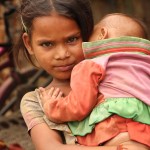
What’s the Initiative all about?
‘Swavlamban’, a Sanskrit term which means Self-dependent. While working exclusively with vulnerable and deprived community, we have found that for more than 80% families, agriculture is the only way to transform their lives. Yet somehow families largely cannot make it due to lack of technical knowledge and aid, financial networks, and the support of government stakeholders (as many did not know such community even exist). Believing that modern farming techniques and government stakeholder’s support can completely change the lives of thousands of children, we have come up with this innovative solution called ‘Swavlamban’.
How it works?
‘Swavlamban’ aims to improve the livelihoods of farmers and their families through progressive farming that decreases input costs, increases production, connects them with financial networks, and takes full advantage of government assistance. Swavlamban targets the problem of poverty in a context where as many as 80% of families survive by means of subsistence farming. Advanced farming practices with the help of progressive government schemes offer farmers the promise of better standards of living, but in remote and underprivileged communities agriculture workers are still not reaching their full potential. Swavlamban seeks to educate farmers about these available practices and government programs in order to propel them towards a future of dignity and a better living wage for them and their families. Consistent and adequate income empowers individuals and creates a better home environment where children are more likely to experience all of their rights.
How do we do it?
Vermi compost/wash
Vermi composting uses earthworms to produce cheap, effective fertilizer. Vermi composting has saved each farmer over Rs.7000 per year on chemical fertilizers, and farmers sold excess worms for additional profits. Farmers also make water based Vermi washes for their fields, prolonging field fertility by months over untreated fields.
System of Rice/Wheat Intensification (SRI and SWI)
SRI and SWI offer farmers a highly efficient way of planting grain crops, allowing for yields as much as 40% higher than traditional methods. We also demonstrated high-yielding Pusa Sugandh-4 and PRH-10 rice strains, further decreasing overhead costs and increasing production.
Machan (Multi-layer) farming
Machan farming uses net roofing to grow a second crop above the ground-level crop, so for farmers growing turmeric or ginger, we promoted “Machan” cultivation of bitter gourd above their ground crop.
Inter-cropping vegetable farming
DEHAT promotes inter-cropping for the best utilization of natural resources. We promote line sowing of grains and suggest leaving a specific distance between lines where vegetables can be cultivated. For example; okra with maize, onion with sugar cane etc.
Crop protection from wild animals
Following last year’s demonstrations, 82 farmers have begun growing onion and garlic this year. This is particularly useful for farmers in areas where wild animals destroy large portions of their crops, as no single case of garlic or onion loss to wild animals has been reported.
Organic waste management
DEHAT promotes homemade paste for pest control in farms. For this, farmers are trained to make and use organic pesticide with tobacco, Azadirachta indica and garlic.
AAS organization and training
All farmers were organized into Aajivika Adhikar Sangathan (AAA) Community-Based Organizations (CBOs). AAS leaders were trained on government schemes and the Mahatma Gandhi National Rural Employment Guarantee Act, as well as record keeping techniques, family-level business planning, and leadership skills.
Community Resource Persons (Barefoot Agriculture Scientists)
DEHAT selects farmer leaders eager to learn and share new technologies, and provides them with training and more exposure to advancements in farming. These farmers are called Community Resource Persons (CRP) and work voluntarily for the community. CRPs not only implement the learning in their own field, but also train and encourage other farmers to follow the newer methods, thus creating a sustainable livelihood programme.







